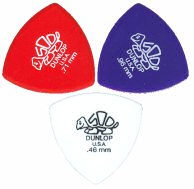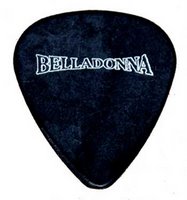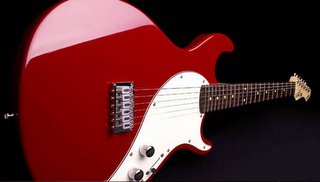Take your pick

What’s in a pick? A pick by any other material will sound as percussive, right? In some ways that’s right. A pick (also called a plectrum), by definition, is “a small thin piece of metal, plastic, bone, or similar material, used to pluck the strings of certain instruments, such as the guitar or lute” (from dictionary.com). Whatever the material is, the object is the same: to make the strings sound louder or take on different tonal qualities.
Picks come in all shapes and sizes, and it is in this variety that all sorts of different sounds can be coaxed out of the guitar. Some are angled, some are rounded, others have ridges. In a sense, a guitar pick is your first and most important equalizer. Here are a just a few examples:
Most guitar picks have an isosceles triangle shape (pictured at right), that is, having two sides of the same length and one short one. Most guitarists seem to prefer this, and for good reason: its sharper angle gives a sharper tone and louder sound. This is good for lead playing or when an aggressive sound is needed.
Personally, however, I don’t use the isosceles pick. First of all, I don’t really like the sharp tone it produces. Secondly, I don’t like the way it feels when it attacks the strings; the angle is too sharp and aggressive for me. Thirdly, it seems such a waste to be able to use only one end of the pick. Fourthly, I don’t like having to fumble with a pick just to get the right end for picking.
So I guess it’s a dead giveaway that the pick I prefer is the equilateral one, with a ll sides being of equal length. The points are less angled, so that when they strike the strings they give out a softer, more mellow sound. It’s also easier to use because all points are the same; no need to fumble to get to the one point that is useful. Just grab it and you’re good to go.
ll sides being of equal length. The points are less angled, so that when they strike the strings they give out a softer, more mellow sound. It’s also easier to use because all points are the same; no need to fumble to get to the one point that is useful. Just grab it and you’re good to go.
As for the material, I use the plain plastic ones mainly because others are either not available here in
USING A PICK
How do you hold a pick? I don’t think there’s a right way to do it, but for me the most comfortable and the one that gives the best sound is this:
This also makes it possible to strum and pick and play leads without having to change the position of the pick.
Again that’s not a hard-and-fast rule. Glen Frey, for example holds his pick like they were a pair of chopsticks, and no one’s complaining about how he plays guitar.
Here are other tips on using a pick:
- Hold it lightly when strumming. Don’t grip it like there’s no tomorrow; just let it sit on your fingers loosely. This gives your sound a bouncy and more percussive feel to it. Of course it goes without saying (but I’m saying it anyway) that you shouldn’t hold it too loosely that you drop it.
- Tighten your grip a little when doing leads. This gives your sound an edge.
- When doing leads, move only your thumb and index finger, not your wrist.
- To do those lightning fast leads, do little circles with your pick instead of moving up or down.
Also, to keep from losing your picks (a problem that afflicts many guitarists I kno w), buy one of those cheap plastic pick holders that you can tape onto your guitar. They can hold up to 10 picks, and they make sure you always have a pick on hand when you play your guitar. I taped mine onto the side of my guitar next to the battery compartment so that it’s not visible to people but still easily accessible.
w), buy one of those cheap plastic pick holders that you can tape onto your guitar. They can hold up to 10 picks, and they make sure you always have a pick on hand when you play your guitar. I taped mine onto the side of my guitar next to the battery compartment so that it’s not visible to people but still easily accessible.










